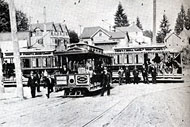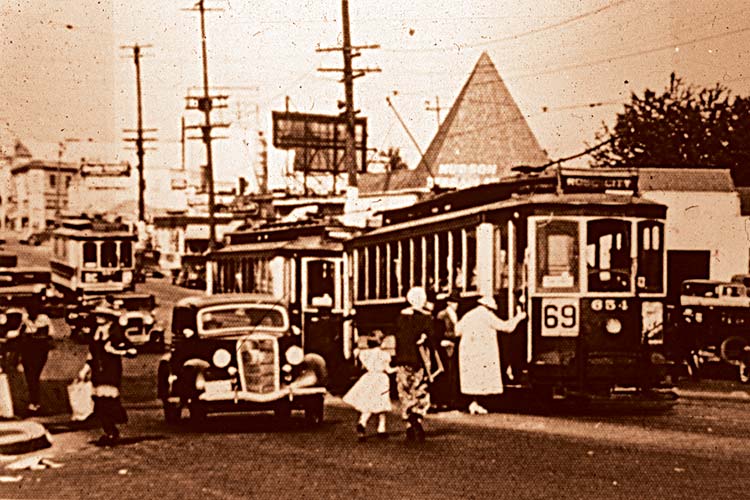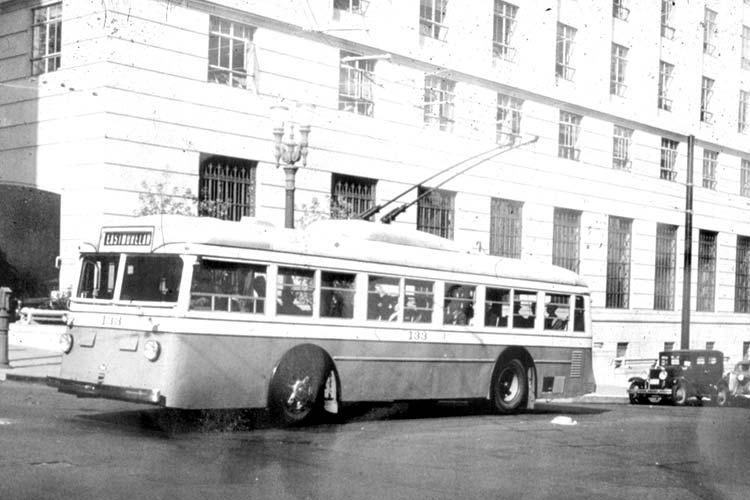A History of Public Transit in Portland
Did you know?
 It’s a meet! Two electric streetcars meet a cable car (foreground) at SW Jefferson and Chapman (now 18th) Streets. Passengers transferred to the cable car for the trip up the trestle to Spring Street.
It’s a meet! Two electric streetcars meet a cable car (foreground) at SW Jefferson and Chapman (now 18th) Streets. Passengers transferred to the cable car for the trip up the trestle to Spring Street.
- Portland was using San Francisco style cable cars at the turn of the century.
- Our region had the first interurban electric rail service in the nation.
- The metropolitan area had an electric streetcar system that stretched from Vancouver to Oregon City and Forest Grove to Estacada.
- By the beginning of the 20th century, Portland was the northern terminus of an electric rail system that operated daily trains to Eugene, Salem, Corvallis and other points throughout the Willamette Valley.
- By 1958 Portland’s extensive rail transit system was gone, replaced by a floundering bus transit system fostered by the “Good Roads Movement.”
Here are some important dates from the complex and colorful history of Portland’s public transportation system:
1872
Just 21 years after Portland is officially founded, the city’s growth prompts the need for a public transportation system. Portland’s first trolleys, brought by steamer from San Francisco by Ben Holladay, were horse and mule drawn, operating on First Avenue from Glisan to Caruthers.
 Horse-drawn trolleys in 1872
Horse-drawn trolleys in 1872
1888
Steam-operated streetcar lines began service, developing into a network that served Hawthorne, Mt. Scott, Mt. Tabor, St. Johns, west Portland and Vancouver, Washington.
 Steam-operated streetcars in 1888
Steam-operated streetcars in 1888
1889
Electric streetcars began service, gradually replacing horse-drawn, cable and steam-powered lines.
Installed by land developers to promote new subdivisions, a network of streetcars eventually extended out to the city limits in all directions.
 Electric streetcars in 1889
Electric streetcars in 1889
1890
An era of major trolley line expansion began that included new lines on the east and west sides of the Willamette River. Several trolley companies provided service, with the first electrified streetcar service beginning by the Willamette Bridge Railway Company in the Albina area. The first cable cars were operating on Fifth Avenue. Fares were five cents.
1891
Large consolidations of financially troubled rail companies began. The City & Suburban Railway absorbed four smaller companies and their lines.
1892
Portland Consolidated Street Railway Company was formed, absorbing three lines.
1893
A 16-mile interurban electric railway and high-voltage transmission line was constructed from Willamette Falls in Oregon City to Portland—one of the first attempts at long-distance electrical transmission. The East Side Railway Company, incorporated in 1891, operated one of the nation’s first interurban electric railways along the alignment. The company carried both passengers and freight. Other interurban lines followed, connecting Portland to its suburbs and outlying towns.
 Interurban electric rail car in 1889
Interurban electric rail car in 1889
1896
The Portland Consolidated Street Railway Company was foreclosed and the Portland Railway Company was formed.
1902
The East Side Railway Company, with its electric passenger/freight railroad service, was sold in foreclosure—resulting the formation of a new company, the Oregon Water Power and Railway Company.
1904
Just prior to the Lewis and Clark Exposition, the electric streetcar was reintroduced on the Council Crest line. The car operated on Washington Street to 23rd and south along Ford to Patton Road.
1905
Portland Railway and City & Suburban merged and were sold to the Clark Family of Philadelphia and Seligman Company of New York for $6 million.
1906
The Portland Railway and City & Suburban consolidated with Oregon Water Power, to become the Portland Railway, Light and Power Company, a system of 28 electric streetcar lines and interurbans.
1910
Interurban railway service now extended from Vancouver south to Eugene and Corvallis, and from Gresham and Troutdale west to Forest Grove and McMinnville. Meanwhile, the “Good Roads” movement gained momentum, and Oregon embraced the automobile — becoming the first state to pay for roads with a gas tax.
 Interurban rail service in 1910
Interurban rail service in 1910
1912
Portland’s population reached 257,490 as rail transit ridership began to peak. New residential areas and suburbs sprang up along the rail lines, making Portland the center of one of the largest urban rail systems in the West.
1918
After World War I, streetcars began to feel the pinch from the automobile.
1920s
Trolley transportation growth slowed. Cutbacks in service and labor economies, such as remodeling equipment for automobile operation, became the norm. Portland Railway changed its name to Portland Electric Power Company (PEPCO), a holding company that included Portland General Electric (PGE), Portland Traction Company and an interurban system.
 Trolleys in the 1920s
Trolleys in the 1920s
1930s
With the Great Depression gripping the nation, buses and trolley coaches began to replace electric streetcars. Several interurban rail lines discontinued passenger service as ridership declined. The aging streetcar system began converting to buses and trolley buses. In time, Portland enjoyed an extensive trolleybus network, particularly on the east side.
 1930s transit bus
1930s transit bus
1941–1949
Portland-area transit ridership peaked at an all-time high during World War II, due in part to the limited availability of automobiles and Portland’s extensive transit infrastructure, but changes were coming.
 Transit bus featuring war bonds advertisement during WWII
Transit bus featuring war bonds advertisement during WWII
1950
The Council Crest, Willamette Heights and 23rd Avenue streetcar lines ceased operations as ridership dropped sharply after the war. Two cars were preserved by the Oregon Electric Railway Historical Society and the City of Portland. As the Portland region continued to grow, the new suburbs beyond the old transit network became increasingly dependent on automobiles; traffic congestion soon became a concern.
 Electric rail transit in 1950
Electric rail transit in 1950
1956
Rose City Transit assumed the city routes of the Portland Traction Company.
1958
The pioneer interurban electric rail line to Oregon City and the trolley buses died out as ridership declined to less than a fifth of its wartime level. The transit system now consisted of seven companies operating buses fueled by gasoline.
1966
The Columbia Region Association of Governments (CRAG), a new regional planning agency, was created.
